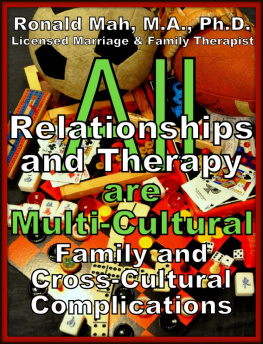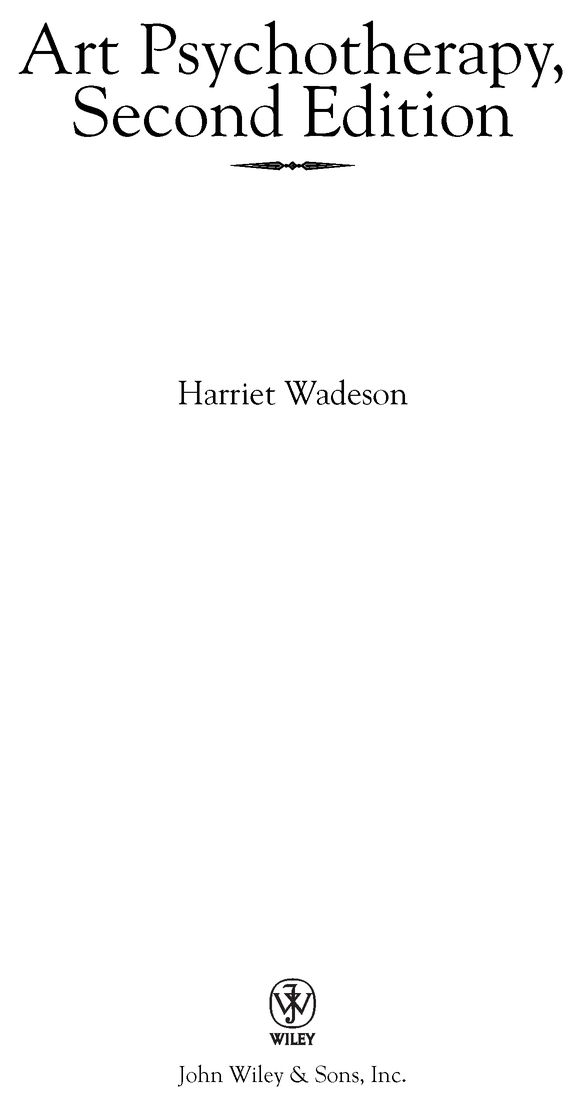Table of Contents
To my children, Lisa, Eric, and Keith, with appreciation for the creative challenges, enrichment, joy, and love they have brought to my life.
Foreword to the First Edition
The concepts and the practices of art psychotherapy have evolved both within and outside the sphere of psychotherapy. In the 1940s, under the pioneering leadership of Margaret Naumburg, the initial framework was psychoanalytic. By studying clinical cases in detail, with artistic expression as the springboard for the patients associations and the therapists interpretations, Naumburg established an invaluable tradition that continues as one component of present-day art psychotherapy.
Other psychoanalytically oriented pioneers, such as Edith Kramer, gave greater emphasis to the healing potentialities of the psychological processes activated in the creative act. Still others, such as Hanna Yaxa Kwiatkowska, began some 50 years ago to expand the scope of art psychotherapy into the interpersonal field of families.
At about that time, innovations suddenly proliferated not only with fresh concepts and methods, but also with newly defined professional roles for art therapists in private practice and in a great array of clinical settings and academic and research institutions. It was my good fortune to be in a position in the Intramural Program of the National Institute of Mental Health (NIMH), where I could readily be aware of these exciting developments, especially in Washington and Philadelphia, and to facilitate, more explicitly, the creative work of Hanna Kwiatkowska and Harriet Wadeson at NIMH.
Over the subsequent years, Harriet Wadeson has continued to add to her clinical, research, and artistic experience. On the one hand, she has published numerous research papers in leading psychiatric journals; on the other hand, she has thoroughly familiarized herself with developments in existential psychology and the Human Potential Movement, using not only graphic arts but also other modalities of expressive therapies.
This book, then, has become a personalized statement arising from her highly diversified professional background. She shows how this personal philosophy can be successfully adapted for use with a variety of people, ranging from those with major and minor psychiatric symptoms to those who wish to enhance their growth in dealing with the problems of living.
As an ingredient of the professionalization of art psychotherapy, Harriet Wadeson discusses forthrightly many of the special problems that art therapists, especially when working in institutional settings, have had while establishing their status and identity. Earlier, art therapists often worked as psychodiagnosticians, and their therapy was defined as adjunctive to the primary therapy of someone else. Wadeson asserts that art therapists should be psychotherapists plus, that is, psychotherapists who are qualified to work alone or in a team of colleagues and who also are trained in the theory and practice of art therapy, have technical expertise in art, and are experienced in using art for self-expression. Surely, this professional identity is a far cry from messing around and killing time with art materials in activities programs. In my view, psychiatrists and psychologists even today have failed to understand how much they can learn from skilled art psychotherapists. Interdisciplinary acknowledgment clearly needs to be reciprocal; the gains then are mutual.
I must also express a personal hoperecognized in this volumethat a sophisticated approach to art psychotherapy will not neglect those deeply impaired individuals whose creactivity becomes manifest through developing simple but often surprising and personally meaningful artistic skills. Also, certain patients can benefit from art therapy that begins stepwise, helping patients to extend their attention span, develop the ability to integrate parts into a whole, improve their motor control, and gain better ability to focus or perceive. Such approaches are quite compatible with a comprehensive approach that also has been enriched by the incorporation of a humanistic tradition concerned with helping all persons, including normal clients, to improve authenticity, individuality, and self-actualization. In varying degrees, all approaches to art therapy require a transfer from the realm of materials to the realms of individual creative processes and interpersonal relationships.
Harriet Wadesons many years as an art therapist have engendered thoughtful and quite detailed guidelines here for dealing with a multiplicity of patients and situations. She devotes an entire chapter or more to each of the following: mania, depression, suicide, schizophrenia, alcoholism, families, and hospitalized and normal groups. A most important chapter explains the hypothesis that the recovery style of schizophrenics (either integrating or sealing-over) can be determined and assessed by the quality of the patients pictorial expression. These findings are documented by collaborative research that suggests the patients recovery style can be elucidated by the quality and expressiveness of his or her pictorial representation. The recovery style can then be a determining factor in planning the best type of treatment by all the staff and in deciding whether drug therapy or other approaches are indicated.
The book as a whole makes it clear that Dr. Wadeson especially enjoys working with the integrators, those persons who want to explore the meaning of disturbing experience to the totality of their lives. At the same time that this work delineates many details of technique and the examination of research hypotheses, Dr. Wadeson effectively models for the reader her interest in the therapists use of self. She shares with us some of her life experiences, dreams, art productions, and even a poem or two. The chapter on research concludes with a statement that gives a clear picture of the authors professional goals: It is my hope that the creativity that is the essence of the profession will be applied to new means of exploration of the human condition through the fertile expressiveness art therapists are trained to perceive.
Harriet Wadeson has waged a successful struggle to make a synthesis that does justice both to her personal viewpoint and to her profession. Grounded in artistic and psychodynamic traditions, she has absorbed and integrated diverse innovations with families and groups without surrendering her interest in personal meaning. She has worked in-depth with psychotic inpatients as well as with dissatisfied normals. Perhaps the most distinctive emphasis in her approachand in my view the most difficult but most therapeutically valuableis her concern with a creative therapeutic alliance. Within a framework of participant observation, in the reciprocal processes between therapist and client, lie the most powerful opportunities for personal growth and therapeutic change. Wadeson addresses both the potentialities and the pitfalls for client and therapist alike in such knotty issues as the extent of self-disclosure by the therapist. In art psychotherapy as in verbal therapies, the complexity of countertransference problems requires self-awareness. Further, she points out that as a therapist in a creative alliance, she does not abandon her own philosophy but is receptive to the clients finding her own way and thus enables the client to experiment with new ways of being.
Lyman C. Wynne














